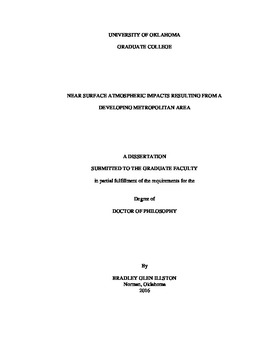| dc.contributor.advisor | Basara, Jeffrey | |
| dc.contributor.author | Illston, Bradley | |
| dc.date.accessioned | 2016-12-14T15:59:27Z | |
| dc.date.available | 2016-12-14T15:59:27Z | |
| dc.date.issued | 2016-12 | |
| dc.identifier.uri | https://hdl.handle.net/11244/47037 | |
| dc.description.abstract | Over the past century, the population of the world has become increasingly urbanized. As a result, cities have become larger and more densely populated than any time in history. This unprecedented growth and rapid modification of the surface has impacted the overlying boundary-layer of the atmosphere. As such, understanding the overall magnitude and spatial variability of these changes has critical value to the ever growing population living within the impacted regions. The goal of this study is to determine the impact of urbanization on near surface atmospheric conditions and how those impacts evolve with time.
The Weather Research & Forecasting (WRF) model was utilized to simulate atmospheric conditions in and around the Oklahoma City area. The WRF output was compared to surface observations from the Oklahoma City Micronet and the Oklahoma Mesonet to quantify model accuracies and biases. The National Land Cover Dataset (NLCD) was subsequently modified to represent land use characteristics from 1890, following the Oklahoma Land Rush, to 2011 at intervals of every 30 years. The WRF model was initialized with modified NLCD land use datasets to determine the impact from a developing metropolitan area.
An analysis of the optimal simulation run times demonstrated that the 24-hour run time provided the most accurate results in the variety of scenarios and the urban heat island index was within about 0.5°C of the verification from surface observing stations. The results yielded an increase in urban heat island indices of over 3.5°C throughout the past 120 years with an over 5.0°C magnitude warming of the near surface air temperatures over and around the developed urban areas. The analysis of the 1890 land use background showed that the natural variability of air temperatures without any influences from the metropolitan area are on the order of 1-2°C.
Additionally, implementing unique methodologies for interpreting urban heat characteristics demonstrated that by utilizing the top 10, 100, 500, and 1000 warmest model simulation pixels as urban values instead of arbitrary points, a more representative value for urban heat island indices was calculated (resulting in a value of about 3.5°C in the summer in 2011). The use of air temperature histograms (in particular for the minimum temperature) of the model grid point’s output showed changes in the historical distribution of air temperature values indicating a transition towards warmer values over time. Additionally, an analysis of the distribution of air temperature values across the entire domain for each of the historical time periods showed the areal spread of air temperature impacts by over 20%. | en_US |
| dc.language | en_US | en_US |
| dc.subject | Meteorology | en_US |
| dc.subject | Urban Heat Island | en_US |
| dc.subject | Numerical Modeling | en_US |
| dc.title | Near Surface Atmospheric Impacts Resulting From a Developing Metropolitan Area | en_US |
| dc.contributor.committeeMember | Klein, Petra | |
| dc.contributor.committeeMember | Richman, Michael | |
| dc.contributor.committeeMember | Hu, Xiaoming | |
| dc.contributor.committeeMember | Tarhule, Aondover | |
| dc.date.manuscript | 2016-12 | |
| dc.thesis.degree | Ph.D. | en_US |
| ou.group | College of Atmospheric & Geographic Sciences::School of Meteorology | en_US |
| shareok.orcid | 0000-0003-0970-7734 | en_US |
